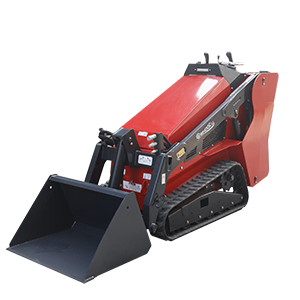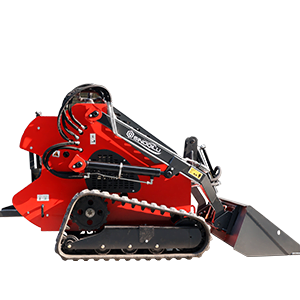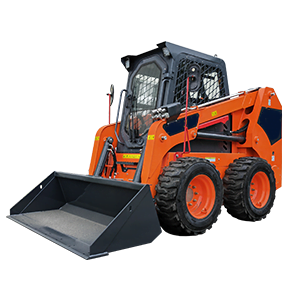E-mail: [email protected] WhatsApp: 8618266768780
Le guide ultime pour choisir la chargeuse compacte directrice adaptée à vos besoins
Introduction
Choosing the right steer skid loader for your needs can be a challenging task. With numerous models, features, and specifications to consider, it’s essential to have a comprehensive understanding of what makes a steer skid loader the best fit for your specific applications. In this guide, we will delve deep into the various factors you should consider when selecting a steer skid loader, ensuring you make an informed decision that maximizes productivity and efficiency.
Understanding Steer Skid Loaders
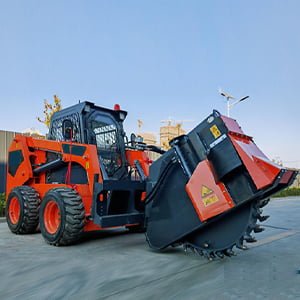
What is a Steer Skid Loader?
A steer skid loader, commonly referred to as a skid steer, is a versatile piece of equipment used in construction, landscaping, and agriculture. It features a rigid frame and lift arms that can be fitted with various attachments, allowing it to perform a wide range of tasks from digging and lifting to grading and loading.
Key Components of a Steer Skid Loader
Understanding the main components of a steer skid loader is crucial for making the right choice. Here are the primary parts:
- Moteur: Powers the loader and its attachments.
- Lift Arms: Used to lift and lower attachments.
- Hydraulique: Essential for the operation of attachments.
- Taxi: Where the operator controls the loader.
- Pneus/Chenilles: Provide mobility and traction.
Factors to Consider When Choosing a Steer Skid Loader
Évaluer vos besoins
Before diving into specific models, it’s important to assess your needs. Consider the following:
- Type de travail: What tasks will the loader be performing?
- Environnement de travail: Are you working on rough terrain, indoors, or in confined spaces?
- Fréquence d'utilisation: How often will you be using the loader?
Evaluating Engine Power and Performance
The engine is the heart of the steer skid loader. Ensure the engine power matches your workload requirements. Higher horsepower models can handle more demanding tasks but may come at a higher cost and fuel consumption.
Hydraulics and Attachments Compatibility
Hydraulic systems are crucial for the functionality of attachments. Ensure the skid loader has a robust hydraulic system that supports the attachments you plan to use. Some common attachments include:
- Seaux:Pour creuser et déplacer des matériaux.
- Fourches: For lifting pallets.
- Tarières:Pour percer des trous.
Considering Loader Size and Lift Capacity
The size and lift capacity of the steer skid loader should align with your project needs. Smaller loaders are more maneuverable and ideal for tight spaces, while larger loaders can handle heavier loads and larger attachments.
Cab Comfort and Operator Safety
Operator comfort and safety are paramount. Look for features such as:
- Rollover Protection: Ensures operator safety in case of tipping.
- Commandes ergonomiques: Reduces operator fatigue.
- Visibilité: Clear lines of sight for safer operation.
Comparing Popular Steer Skid Loader Models
Below is a table comparing some popular steer skid loader models to help you make an informed decision:
| Modèle | Puissance du moteur (HP) | Capacité de levage (lb) | Poids en ordre de marche (lb) | Principales caractéristiques |
|---|---|---|---|---|
| Bobcat S650 | 74 | 2,690 | 8,061 | Superior hydraulics, versatile |
| Qilu QL2200 | 72 | 2,204 | 6878 | Pilot control, dual throttle valve design |
| John Deere 320G | 69 | 2,600 | 8,195 | Efficient fuel usage, strong build |
| Case SR270B | 90 | 2,700 | 8,090 | High engine power, durable |
| Kubota SSV75 | 74.3 | 2,690 | 8,165 | Comfortable cab, easy maintenance |
Maintenance and Longevity of Your Steer Skid Loader
Conseils d'entretien de routine
Maintaining your steer skid loader is crucial for its longevity and performance. Here are some tips:
- Regularly Check Fluids: Ensure hydraulic, engine oil, and coolant levels are optimal.
- Inspect Tires/Tracks: Look for wear and tear and maintain proper pressure.
- Clean Attachments: Prevent buildup that can affect performance.
Common Issues and Troubleshooting
Understanding common issues can help you troubleshoot problems efficiently:
- Engine Overheating: Check coolant levels and clean the radiator.
- Hydraulic System Failure: Inspect for leaks and ensure proper fluid levels.
- Electrical Problems: Check battery connections and fuses.
Maximizing Efficiency with Your Steer Skid Loader
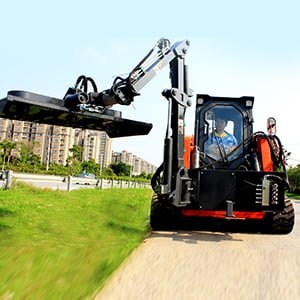
Best Practices for Operation
Efficient operation not only extends the life of your loader but also increases productivity. Follow these practices:
- Formation adéquate: Ensure operators are well-trained.
- Correct Attachment Use: Match attachments with tasks for optimal performance.
- Inspections de routine: Regularly inspect the loader for any issues.
Enhancing Productivity with Advanced Features
Modern steer skid loaders come with advanced features that can enhance productivity:
- Télématique: Monitor performance and maintenance needs remotely.
- Contrôles automatisés: Improve precision and ease of operation.
- Enhanced Hydraulics: Support for high-performance attachments.
Conclusion
Choisir le bon chargeuse compacte directrice requires a thorough understanding of your needs, the loader’s specifications, and the tasks at hand. By considering factors such as engine power, hydraulics, size, and operator comfort, you can make an informed decision that ensures efficiency and productivity on the job site. Regular maintenance and proper operation further extend the lifespan and performance of your steer skid loader, making it a valuable asset for your projects.
FAQ
What is the difference between a skid steer and a track loader?
A skid steer has wheels, making it suitable for hard surfaces and paved areas, while a track loader has tracks, providing better traction on soft, uneven terrain.Skid steers are generally more maneuverable in tight spaces due to their ability to turn in place, while track loaders are known for their stability on rough terrain. Each machine has its own strengths and weaknesses, making them suitable for different types of construction and landscaping projects.
How often should I service my steer skid loader?
Regular servicing should be done every 250-500 hours of operation, depending on the manufacturer’s recommendations and usage intensity.In addition to regular servicing, it’s important to conduct routine maintenance checks and inspections to ensure the equipment is functioning properly and to catch any potential issues early on. This can help prevent costly repairs and downtime in the long run.
Can I use any attachment with my steer skid loader?
No, you must ensure that the attachment is compatible with your loader’s hydraulic system and lift capacity.
What are the most common attachments used with steer skid loaders?
Common attachments include buckets, forks, augers, grapples, and trenchers.
How do I choose the right size steer skid loader?
Consider the work environment, type of tasks, and lift capacity requirements to choose the right size. Smaller models are ideal for confined spaces, while larger models handle heavier loads and bigger projects.
À propos de nous
Shandong Qilu Industrial Co., Ltd. est un fabricant et exportateur professionnel intégrant le développement et la production d'excavatrices, de chargeurs et de tracteurs. Nous fournissons le meilleur service, absolument.
Messages récents
Démo vidéo
-1.png)
Contactez-nous aujourd'hui !
Une question, un devis ou une demande ? Cliquez sur le bouton pour envoyer le message.
Qilu Industrial sera toujours là pour vous aider.

